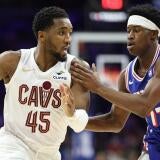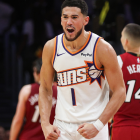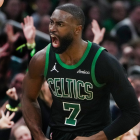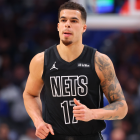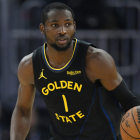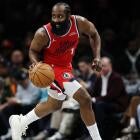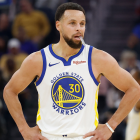Duncan, Garnett, Bosh, Amar'e redefined position that no longer needs definition
This offseason, we've said goodbye, at least for now, to a revolutionary group of power forwards

What is a power forward?
Well, for a long time, it was the second-tallest man that a team put on the floor. Simple as that. The power forwards of yesteryear were more power than anything that moved the game forward, a decidedly unglamorous crop of plodders and bangers that defined a position which -- save for the occasional exception, a Karl Malone here, a Charles Barkley or Elvin Hayes or Kevin McHale there -- was largely comprised by the Kurt Rambis' and Rick Mahorns and Charles Oakleys of the world.
Rarely featured in an offensive set, these were guys who were essentially charged with setting whiplash-inducing screens when they weren't shoving someone into the second row for a rebound. They helped teams win in ways casual fans didn't necessarily recognize or appreciate. Power forward certainly wasn't the versatile, even sexy position that it has become in this new-age era of size-defying skill.
That, as much as anything, is the legacy of a truly revolutionary quartet of "power forwards" that the NBA, for different reasons, has said goodbye to this offseason -- or, in the case of Chris Bosh, at least won't be on the court to start the year. Indeed, Tim Duncan, Kevin Garnett, Amar'e Stoudemire and Bosh don't simply walk away with a great career to their credit. They redefined a position by transcending definition.
This quartet starts, of course, with Duncan and Garnett, with their 15 All-Star appearances apiece, and their spots in the Hall of Fame, secured. Duncan will now be "DNP-Old" for an entire season, and Garnett can't be called "The Kid" anymore, not after turning 40.
Meanwhile, Bosh and Stoudemire, with 11 and six All-Star appearances, respectively, also aren't likely to be active this season, at least not in the NBA. Stoudemire, frustrated by his lack of playing time with Miami last postseason, left for Hapoel Jerusalem of the Israeli Basketball Premier League. And Bosh hasn't been cleared by the Heat for training camp, with Pat Riley making it clear Bosh's Heat days -- at the least -- are done.
Bosh and Stoudemire, still just 32 and 33, never quite got into Duncan's or Garnett's class, but at their respective heights -- Bosh prior to his blood clotting ailments and Stoudemire prior to knee trouble -- they were great, great players. They were among the prizes of 2010 free agent class, which was among the most hyped in history, and appeared to be the primary bridges to the next generation of elite power forwards, players who these days also tend to serve as undersized centers in small-ball systems.
Each will be seen as unfinished stories to some degree, and yet, for the purposes of this piece, try to think of them as emblematic of a position's evolution. Bosh, with his versatility and adaptability, whether blitzing pick-and-rolls or stretching his shooting range to serve team needs, especially as the most misunderstood member of Miami's two-time champion Big Three. Stoudemire, with his athletic explosiveness and screen-setting precision, making him a pick-and-roll monster alongside Steve Nash in the Suns' "Seven Seconds or Less" system" -- even if his defensive work tended to be something short of dominant.
They didn't necessarily play the power forward position like so many of their predecessors -- and Stoudemire, after coming in as a power forward, actually played a little more center overall, according to Basketball-Reference.com. Then again, neither did Duncan nor Garnett. Each resisted the customary characterizations. Duncan didn't want to be known as a center, not even when he was paired with David Robinson, a player he looked up to. Garnett didn't want to be known as a 7-footer, so he called himself 6-foot-11 when he measured 7-foot-1 in shoes.
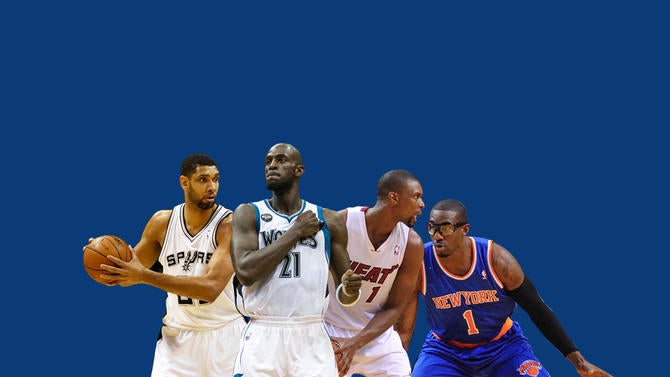
Duncan and Ganrett rose to the rafters of the sport using entirely different means. You picture Duncan calmly squaring his man up and going glass. You picture Garnett frequently going nuts, ranting at opponents and teammates with a expletive repertoire as expansive as his endless wingspan. Garnett entered as an off-the-charts athlete, while Duncan was a by-the-books clinician. Duncan didn't intimidate like Garnett, but his teams still incinerated yours, never winning fewer than 61 percent of their games in a season. And yes, there were the five titles too, compared to one for Garnett, after his trade from Minnesota to Boston.
In previous eras, both would have been called centers, whether they liked it or not. They preferred to be power forwards. So did Bosh, incidentally. He always resisted being the "5" until the Heat had no other choice, and won a championship with him in that spot in 2012 after he returned from an abdominal injury.
This has become an increasingly challenging task, trying to determine who plays what -- and really, does it matter? Dirk Nowitzki, now 38 and with 13 All-Star appearances, has played 68 percent power forward according to Basketball-Reference.com, while Pau Gasol has played 67 percent center, while earning six All-Star appearances for the Grizzlies, Lakers and Bulls. We think of both simply as skilled seven-footers.
And that's what this is about: skill. That's what Duncan and Garnett had in spades, and to an extent, Bosh and Stoudemire, too. So when we ask if there will be another like them, it's not so much about whether the particular player plays power forward all the time, or plays it like power forwards used to play it, or even exactly how Duncan and Garnett played it, but whether the player can impact the game in enough ways to blur all the lines.
So what are the options?
LaMarcus Aldridge, Al Horford and Paul Millsap all play a lot of power forward -- with each also playing another frontcourt spot -- and are all under-appreciated to some degree, even as they've made five, four and three All-Star teams, respectively. Still, they're not franchise pillars close to Duncan or Garnett caliber.
Kevin Love (28), Blake Griffin (27) and Draymond Green (26) all have unique gifts, and room for growth in their games. But Love has now settled, somewhat uncomfortably, into the third man role in Cleveland, Griffin hasn't stayed healthy (or in the eyes of some, matured) enough to fulfill all of his athletic potential, and Green -- for all his defensive dynamism -- will be the fourth option in the Warriors' starting lineup this season.
So the next Duncan- or Garnett-like game-changer may have to come from the younger class. Anthony Davis is 23. Kristaps Porzingis is 21. Karl-Anthony Towns is still 20 until November. Davis played more center last season, though he is at 64 percent power forward for his career. Porzingis is 7-foot-3, but played 70 percent at power forward last season, and will likely play a similar amount this season, though new center Joakim Noah is four inches shorter. Towns? He played 98 percent at center last season.
But that two percent at power forward?
That was promising, too.
It looked exactly like you would expect a power forward to play, because -- thanks to some of the greats who are gone -- a power forward can proudly play just about any way.







